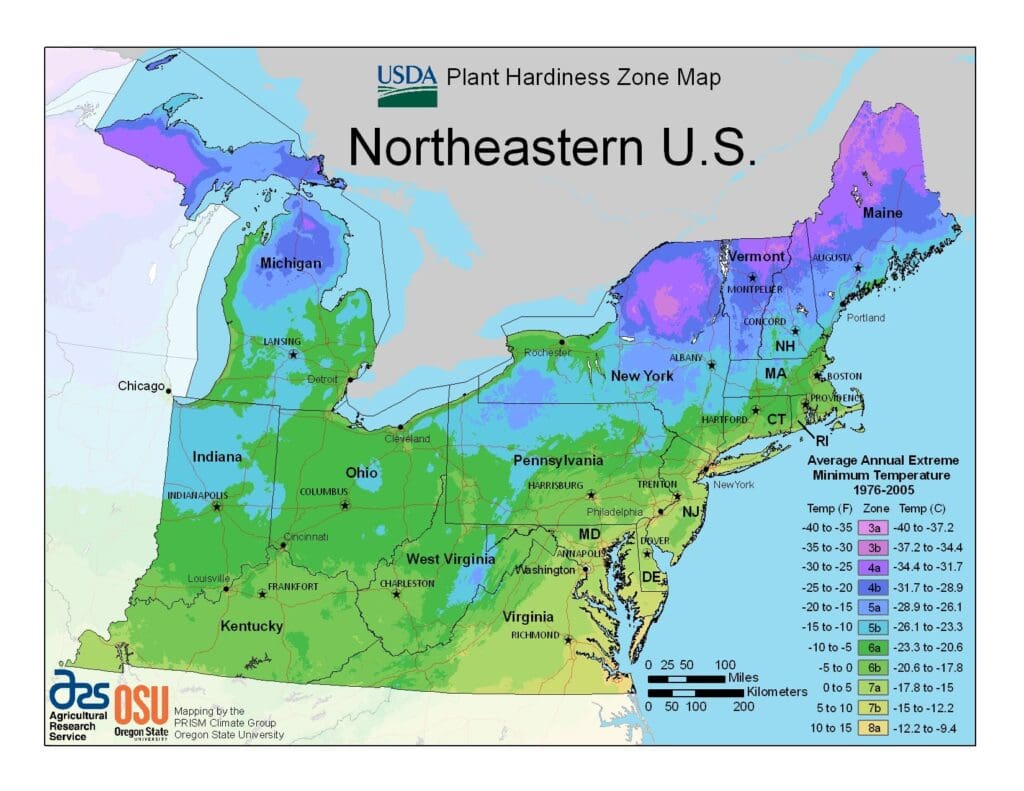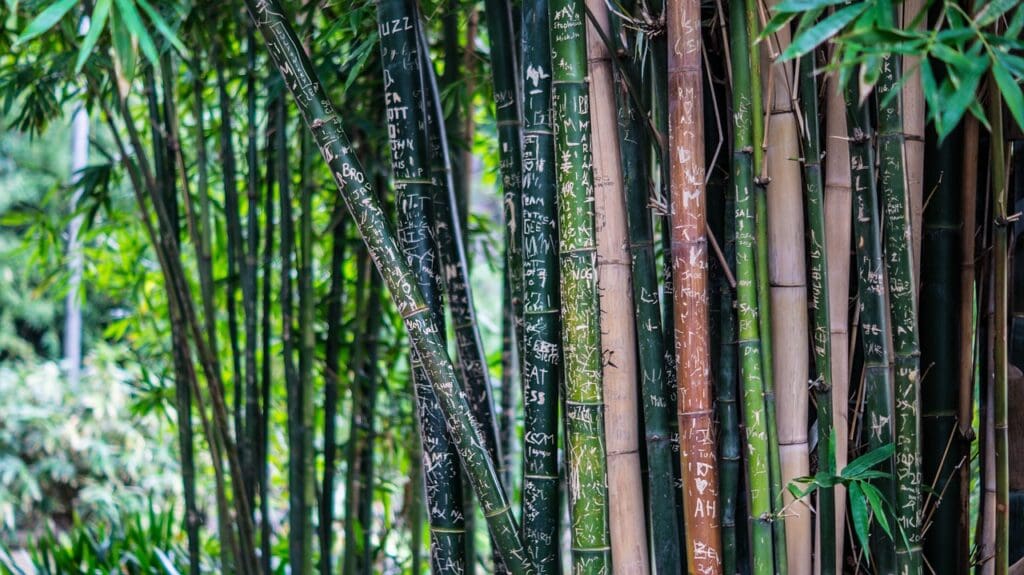Growing Bamboo In Maryland
With careful selection of hardy bamboo species and proper care, it is possible to grow bamboo successfully in this region. This article provides valuable information for individuals interested in growing bamboo in Maryland.
Key Takeaways
- Hardy bamboo species like Fargesia, Bambusa, and Chusquea can withstand cold temperatures in Maryland.
- Bamboo grows best in moist, well-drained soil rich in organic matter.
- Containment strategies like planting in containers or using physical barriers are recommended to prevent bamboo – especially running bamboo – from spreading outside of the initial planting area.
- Regular watering, especially during hot summer months, is necessary for bamboo.
Best Bamboo Species for Maryland
Several bamboo species, including Fargesia, Bambusa, and Chusquea varieties, are well-suited for Maryland’s challenging climate and can thrive in the state with proper care and maintenance.

These bamboo species are known for their adaptability and resilience, making them ideal choices for Maryland’s climate. Fargesia varieties, such as Fargesia robusta and Fargesia nitida, are non-invasive clumping bamboos that can withstand cold temperatures and drought conditions.
Bambusa species, such as Bambusa multiplex and Bambusa oldhamii, are more suitable for the southern regions of Maryland, where the climate is milder. Chusquea varieties, such as Chusquea culeou and Chusquea gigantea, are cold-hardy bamboos that can tolerate Maryland’s winters. With proper care, such as regular watering, mulching, and pruning, these bamboo species can thrive and add beauty to Maryland landscapes.
Ideal Soil Conditions
Optimal soil conditions for successful cultivation of bamboo in the region include well-drained soil with a high organic matter content. To ensure proper soil preparation, it is recommended to start by loosening the soil and removing any weeds or debris.
Adding compost or well-rotted manure can help enrich the soil with organic matter, promoting healthy growth of bamboo plants. Additionally, incorporating organic matter enrichment methods like mulching can help retain moisture in the soil and keep roots cool during hot summer months.
Watering and Irrigation Tips
Adequate water supply is crucial for maintaining the health and vigor of bamboo plants, ensuring they receive sufficient moisture to support their growth and development. Here are some key tips for watering and irrigation when growing bamboo in Maryland:
- Proper watering techniques: Water deeply and infrequently to encourage deep root growth. Avoid shallow, frequent watering as it can lead to weak roots and susceptibility to drought.
- Irrigation systems for bamboo: Consider using drip irrigation or soaker hoses to deliver water directly to the base of the plant. This helps prevent water waste through evaporation and ensures efficient water distribution.
- Drought-resistant bamboo species: Choose bamboo varieties that are known for their tolerance to dry conditions, such as Fargesia robusta or Bambusa multiplex ‘Alphonse Karr’. These species have adapted mechanisms to conserve water during periods of drought.
- Monitor soil moisture: Regularly check the soil’s moisture level by sticking your finger into the ground near the roots. If it feels dry, it’s time to water. Aim for consistently moist but not overly saturated soil.
Containment Strategies
One effective approach to prevent bamboo from becoming an invasive plant and spreading beyond its initial planting area is by implementing containment strategies such as using physical barriers or planting in containers.
Bamboo containment is crucial for managing invasive species and preventing them from taking over the surrounding areas.
Physical barriers, such as underground rhizome barriers made of high-density polyethylene, can be installed around the bamboo plants to restrict their spread. These barriers should extend at least 2 feet deep into the soil to prevent rhizomes from escaping underground.
Another option is to plant bamboo in containers, which provides better control over its growth and prevents it from spreading through rhizomes. Containers should be large enough to accommodate the root system of the bamboo and should have drainage holes to avoid waterlogging.
Benefits of Growing Bamboo in Maryland
An array of advantages can be gained from cultivating bamboo.
One significant benefit is carbon sequestration, as bamboo has the ability to absorb large amounts of carbon dioxide from the atmosphere. This makes a contribution to mitigating climate change and reducing greenhouse gas emissions.
Moreover, growing bamboo provides habitat for wildlife, including birds and animals that rely on it for shelter and food. By incorporating bamboo into their landscapes or gardens, Maryland residents can contribute to environmental conservation efforts while enjoying the aesthetic value this versatile plant offers.
Care and Maintenance Tips
To ensure healthy growth and prevent any issues, it is crucial to employ proper care practices. Here are some essential techniques:
-
Bamboo pruning techniques: Regular pruning helps maintain the desired shape and size of bamboo plants. Removing dead or weak canes promotes new growth and prevents overcrowding.
-
Preventing bamboo diseases: Keeping an eye out for common diseases like leaf spot, rust, or root rot is vital. Providing adequate air circulation, avoiding overwatering, and promptly treating any signs of disease are key preventive measures.
-
Bamboo propagation methods: Bamboo can be propagated through rhizome division or by collecting seeds. Rhizome division involves separating healthy sections of rhizomes to create new plants, while seed collection requires patience as bamboo seeds may take several years to germinate.
-
Utilizing containment strategies: As mentioned earlier, using physical barriers or planting bamboo in containers can prevent its spread beyond the desired area.
Using Bamboo for Landscaping
One effective way to enhance the aesthetic appeal of a landscape and promote environmental sustainability is by incorporating bamboo, a versatile and resilient plant known for its rapid growth and diverse uses.
Bamboo can be used in various ways to create privacy screens, garden ornaments, and add a touch of tropical flair to urban landscaping projects.
Bamboo privacy screens can provide an attractive and natural barrier between properties or create secluded outdoor spaces.
Additionally, bamboo garden ornaments such as trellises, fences, or decorative structures can add elegance and sophistication to any garden design.
In urban landscaping, bamboo can be used strategically to soften the harsh lines of buildings or create green walls that improve air quality.
With its beauty and functionality, bamboo offers endless possibilities for enhancing landscapes while also benefiting the environment.
Frequently Asked Questions
Q: Is bamboo invasive in Maryland?
A: Some species of running bamboo can be invasive if not properly controlled. However, there are clumping bamboo species that are native to Maryland and are not considered invasive.
Q: Can I grow any type of bamboo in Maryland?
A: It is best to choose bamboo varieties that are well-suited to the local climate. These varieties are more likely to thrive and require less maintenance.
Q: Can bamboo grow in cold winters?
A: Yes, bamboo can tolerate cold winters. However, some varieties may be more cold-hardy than others. It is important to consider the specific variety you are planting and its tolerance to cold temperatures.
Q: Can I control the growth of bamboo?
A: Yes, the growth of bamboo can be controlled by using physical barriers such as trenches or using a root barrier. Regular pruning and maintenance can also help control the spread of bamboo.
Q: How do I prevent bamboo from spreading into my neighbor’s yard?
A: To prevent bamboo from spreading into your neighbor’s yard, you can install a root barrier or use physical barriers. Regular maintenance and monitoring can also help ensure the bamboo stays within your desired area.
Q: Can I grow bamboo without it becoming invasive?
A: Yes, by choosing clumping bamboo species you can grow bamboo without it becoming invasive. Proper maintenance and control measures are also essential.
Q: Are there any restrictions or regulations for growing bamboo in Maryland?
A: It is advisable to check with your local Department of Agriculture or government agency for any regulations or guidelines regarding the growing of bamboo in Maryland. Some places may have restrictions due to its potential invasive nature.
Conclusion
In conclusion, growing bamboo in Maryland can be challenging due to various factors such as cold temperatures, soil conditions, pests, and diseases. However, by selecting hardy bamboo species like Fargesia, Bambusa, and Chusquea and providing the ideal soil conditions and regular watering, bamboo can thrive in this region.
Containment strategies like planting in containers or using physical barriers are recommended to prevent the spread of bamboo beyond the desired area.

